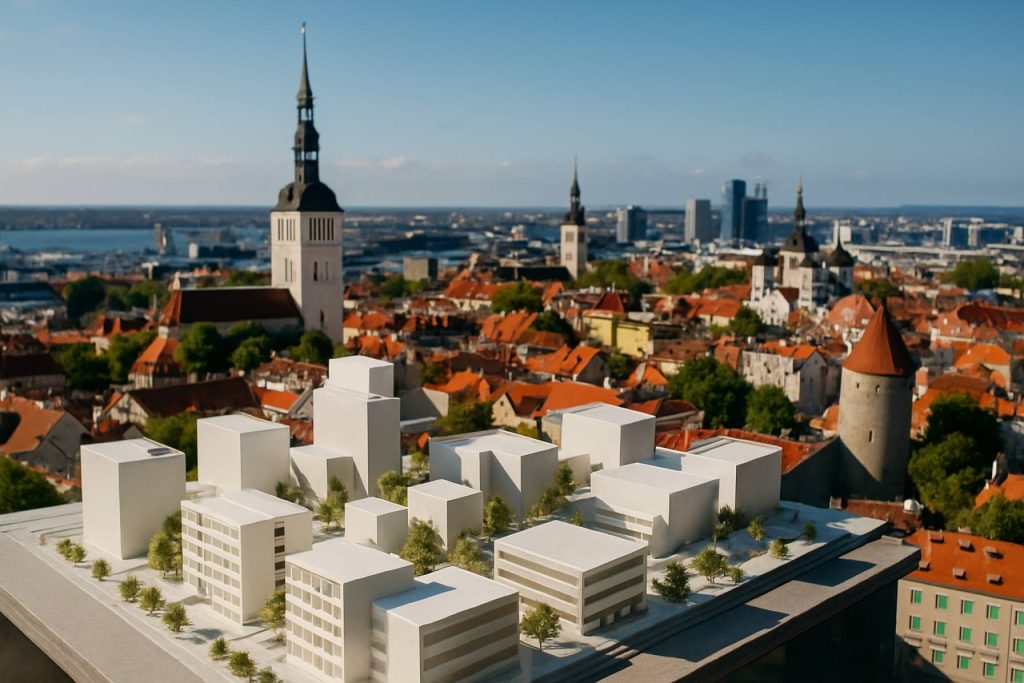
Table of Contents
- Executive Summary: Key Insights for 2025 and Beyond
- The Current Landscape: Estonia’s Real Estate Market at a Glance
- New Developments and Urban Expansion Hotspots
- Legal Framework: Property Ownership, Regulations, and Taxation (Source: maaamet.ee, emta.ee)
- Foreign Investment: Opportunities, Restrictions, and Compliance (Source: investinestonia.com, mkm.ee)
- Residential vs. Commercial: Market Segmentation and Demand Drivers
- Key Market Statistics: Prices, Yields, and Transaction Volumes (Source: maaamet.ee, statistikaamet.ee)
- Sustainability and Smart Cities: Green Building Initiatives (Source: mkm.ee, keskkonnaamet.ee)
- Risks and Challenges: Economic, Political, and Regulatory Factors
- Future Outlook: Forecasts for 2025–2030 and Expert Recommendations
- Sources & References
Executive Summary: Key Insights for 2025 and Beyond
The Estonian real estate sector in 2025 is entering a period marked by both resilience and transformation, underpinned by robust legal frameworks, digital innovation, and shifting demographic and economic trends. Despite global uncertainties, the market demonstrates stability, buoyed by prudent regulation and a transparent system of property registration and transactions overseen by the Ministry of Justice and the Estonian Chamber of Notaries.
Key legislative pillars include the Law of Property Act and the Land Register Act, which together ensure secure ownership, efficient conveyancing, and reliable public access to property data. The mandatory involvement of notaries in real estate transactions continues to minimize fraud and increase confidence for both domestic and foreign investors. Compliance with anti-money laundering (AML) regulations, coordinated by the Estonian Financial Supervision and Resolution Authority, remains a top priority, with stricter customer due diligence obligations implemented in recent years.
Statistically, 2024 saw a moderate decline in transaction volumes—down by approximately 10% compared to the previous year—reflecting the impact of rising interest rates and inflationary pressures. Nevertheless, the average price per square meter in Tallinn and other major cities remained stable or registered slight growth, indicating underlying demand resilience. According to the Statistics Estonia, the average price per square meter for apartments in Tallinn stood at around €3,300 in early 2025, while regional disparities persist, with rural prices significantly lower.
The rental market is experiencing upward pressure due to continued urbanization and migration, especially in the capital, where rental yields remain attractive. There is also a notable increase in demand for energy-efficient and smart homes, aligning with Estonia’s national climate targets and EU directives. This trend is supported by incentives and building standards overseen by the Ministry of Economic Affairs and Communications.
Looking ahead, the Estonian real estate market is expected to gradually recover in transaction activity as interest rates stabilize and economic confidence returns. Digitalization—exemplified by Estonia’s pioneering e-Government infrastructure—will further streamline property transactions and compliance procedures. The sector’s outlook is positive, with continued investment in urban development, sustainable construction, and digital solutions positioning Estonia as a forward-looking real estate environment for 2025 and beyond.
The Current Landscape: Estonia’s Real Estate Market at a Glance
Estonia’s real estate market in 2025 presents a dynamic environment shaped by evolving economic trends, regulatory adjustments, and digital innovation. The sector has demonstrated relative stability despite broader regional uncertainties, with transaction volumes and price growth moderating after the rapid escalation seen in the pandemic and post-pandemic years.
According to the Statistics Estonia, the number of real estate transactions in 2024 slightly decreased compared to previous highs, reflecting a more cautious market sentiment. Residential property prices in major cities such as Tallinn, Tartu, and Pärnu have stabilized, with annual price growth averaging around 3–5%. The rental market remains robust, supported by continued urbanization and a steady influx of international professionals.
Legislatively, the real estate sector in Estonia is governed primarily by the Law of Property Act (Asjaõigusseadus) and the Land Register Act (Kinnistusraamatuseadus). In recent years, amendments have focused on streamlining digital processes, enhancing transparency, and strengthening anti-money laundering (AML) compliance. The Estonian Chamber of Notaries has played a significant role in digitizing property transactions, enabling remote notarization and secure electronic document handling, which has improved efficiency and accessibility for both domestic and foreign investors.
Compliance requirements, particularly regarding AML, have become more stringent following guidance from the Estonian Financial Supervision and Resolution Authority and the Estonian Police and Border Guard Board. Real estate agencies and professionals are obligated to carry out thorough customer due diligence, report suspicious activity, and maintain detailed records to counter financial crime risks.
Looking ahead, the Estonian Ministry of Economic Affairs and Communications projects a continued focus on sustainable development and energy efficiency in real estate. The government is incentivizing green building practices and the renovation of existing housing stock to meet national and EU climate targets (Ministry of Economic Affairs and Communications). Digital solutions are expected to further transform property management, transactions, and urban planning, reinforcing Estonia’s reputation as a leader in e-governance.
In summary, Estonia’s real estate market in 2025 is marked by stabilized growth, rigorous compliance, and ongoing digitalization. While short-term uncertainties persist, especially regarding inflation and regional security, the outlook remains positive, with innovation and regulatory clarity underpinning the sector’s resilience.
New Developments and Urban Expansion Hotspots
Estonia’s real estate sector continues to evolve dynamically in 2025, with particular momentum in new developments and the emergence of urban expansion hotspots. The capital, Tallinn, and its surrounding municipalities remain the core of real estate activity, but significant growth is also evident in regional centers such as Tartu and Pärnu. According to the most recent data, residential construction and mixed-use projects are on the rise, fueled by population growth, sustained inward migration, and the government’s ongoing digital transformation initiatives.
In Tallinn, the port area and districts like Kalamaja and Ülemiste City are notable for large-scale urban renewal. Ülemiste City, in particular, continues its expansion as a leading business campus, integrating residential, commercial, and innovation-driven facilities. The city’s commitment to sustainable urban planning is further reflected in its adherence to green building standards and the integration of smart city technologies. Tartu, meanwhile, is leveraging its reputation as an educational and technological hub to attract new investments in both residential and commercial real estate developments.
The legal framework governing real estate development in Estonia is robust and transparent. The Ministry of Justice oversees the legislative environment, with the Building Code and Planning Act forming the backbone of compliance for new projects. Developers must adhere to strict environmental and zoning regulations administered by local authorities, ensuring that urban expansion aligns with sustainable growth policies. The Estonian Land Board provides open access to land registry data, further enhancing market transparency and investor confidence.
Key statistics from the Statistics Estonia highlight a steady increase in issued building permits and construction volumes over the past year. As of early 2025, residential property prices in Tallinn have stabilized after rapid growth, with an average price per square meter approaching €3,200. Vacancy rates for new commercial properties remain low in prime areas, reflecting strong demand for modern office and retail spaces. Regional cities are experiencing moderate price growth, supported by infrastructure investments and improved connectivity.
Looking ahead, Estonia’s real estate outlook appears positive, underpinned by favorable demographic trends, continued digitalization, and government incentives for energy-efficient construction. However, compliance with evolving environmental standards and urban planning regulations will remain crucial for developers. The government’s focus on smart city initiatives and sustainable urbanization is expected to shape the next wave of expansion hotspots, ensuring balanced growth across the country.
Legal Framework: Property Ownership, Regulations, and Taxation (Source: maaamet.ee, emta.ee)
Estonia’s legal framework for real estate ownership is grounded in principles of transparency, security, and facilitation of both domestic and foreign property investment. The Estonian Land Board (Maa-amet) maintains a comprehensive land register, ensuring that property rights, encumbrances, and transactions are publicly recorded and digitally accessible. Property rights are protected under the Estonian Law of Property Act, which stipulates clear procedures for acquisition, transfer, and registration of real estate. Foreign individuals and companies from the European Union and OECD countries generally enjoy the same property rights as Estonian citizens, though certain restrictions apply to the acquisition of agricultural and forest land by non-residents.
Property transactions must be notarized and registered in the Land Register to be legally valid. Electronic systems have expedited procedures, with registration times commonly as short as two to five days in 2024 and anticipated to remain efficient in 2025. Compliance with building regulations is overseen by local municipalities, which issue construction and occupancy permits in accordance with the Building Code.
On the fiscal side, Estonia has a straightforward real estate tax regime. There is no annual property tax on residential land or buildings, but land tax (maamaks) is levied on landowners based on the assessed value of the land. The tax rates, set by local governments, range from 0.1% to 2.5% of the taxable value per year, with the precise rate determined at the municipal level. Payment is mandatory for all landowners, including foreign entities, and the Estonian Tax and Customs Board (EMTA) is responsible for collection and compliance oversight.
For property sales, capital gains are subject to personal or corporate income tax, typically at the standard 20% rate. However, exemptions may apply for the sale of a primary residence if certain criteria are met. Value-added tax (VAT) at 20% applies to new developments and commercial properties, but not to most resales of residential real estate.
Looking ahead to 2025 and beyond, Estonia is expected to retain its investor-friendly legal environment, with ongoing digitalization initiatives further streamlining compliance and registration processes. Legislative amendments are under discussion to clarify foreign ownership rules and enhance anti-money laundering controls, reflecting wider EU regulatory trends. The efficient, transparent legal and fiscal framework remains a key factor in Estonia’s resilient real estate sector.
Foreign Investment: Opportunities, Restrictions, and Compliance (Source: investinestonia.com, mkm.ee)
Estonia’s real estate market continues to attract foreign investors due to its open economy, digital infrastructure, and transparent legal framework. In 2025, the sector remains dynamic, with both residential and commercial properties drawing international attention. The government maintains a liberal investment regime, though certain restrictions and compliance requirements apply, especially concerning agricultural and forest land.
Foreign nationals and companies are generally allowed to purchase and own real estate in Estonia, including land, without major limitations. However, non-EU/EEA citizens face specific restrictions regarding the acquisition of agricultural and forest land. Such transactions may require prior permission from the local government, and in some cases, the buyer must demonstrate a connection to Estonia, such as permanent residence or conducting business activities in the country. These measures are designed to protect national interests and ensure sustainable land use, as outlined by the Estonian Land Reform Act and related regulations.
Compliance for foreign investors involves adhering to due diligence requirements, anti-money laundering (AML) regulations, and proper registration of property rights. The Estonian Land Register, maintained by the Centre of Registers and Information Systems, ensures transparency and legal certainty in all real estate transactions. Notaries play a central role in verifying the legality of transactions, checking the identities of parties, and ensuring that deals comply with national and EU legislation.
Recent years have seen a steady increase in foreign direct investment (FDI) related to real estate. According to Invest in Estonia, the sector accounted for a significant portion of total FDI inflows, with investors from Finland, Sweden, and Germany among the most active. In 2024, the value of real estate transactions involving foreign buyers grew by approximately 5%, despite global economic uncertainties.
Looking ahead to 2025 and beyond, the outlook for foreign investment in Estonian real estate remains positive. Urbanization, a growing technology sector, and Estonia’s reputation as a business-friendly environment are expected to sustain demand. The Ministry of Economic Affairs and Communications (Ministry of Economic Affairs and Communications) continues to refine policies to balance openness with the need for rigorous compliance and sustainable development. Notably, digitization of land and property records is expected to further streamline transactions and bolster investor confidence.
Foreign investors are advised to stay abreast of evolving regulations and ensure full compliance with all legal and tax obligations. Consulting with qualified local legal professionals and leveraging Estonia’s e-government services can facilitate smooth entry and ongoing operations in the market.
Residential vs. Commercial: Market Segmentation and Demand Drivers
The Estonian real estate market continues to display distinct segmentation between residential and commercial sectors in 2025, shaped by divergent demand drivers, regulatory frameworks, and economic forces.
Residential Market: The residential sector has historically been buoyed by robust demand in urban centers such as Tallinn, Tartu, and Pärnu. Despite moderate price corrections in late 2023 and early 2024, demand for apartments and private houses remains resilient in 2025, underpinned by demographic trends, wage growth, and ongoing urbanization. According to Statistics Estonia, the population in Tallinn continues to rise, fueling sustained interest in new developments and renovation projects. However, higher interest rates and stricter lending criteria, as stipulated by the Eesti Pank (Bank of Estonia), have tempered speculative activity and contributed to a stabilization of price growth.
The legal framework for residential property transactions is governed by the Law of Obligations Act and the Land Register Act. All transfers of ownership must be notarized and registered in the Estonian Land Register. Recently implemented guidelines on anti-money laundering by the Estonian Financial Supervision and Resolution Authority place additional compliance requirements on real estate agencies and notaries, particularly in verifying the identity of buyers and the origin of funds.
Commercial Market: The commercial real estate segment in Estonia—comprising office, retail, industrial, and logistics properties—has faced more pronounced adjustments since the pandemic and amid global economic uncertainty. Office demand has shifted due to hybrid work models, leading to increased vacancy rates in some submarkets. The Estonian Real Estate School notes that while prime office rents have remained relatively stable, secondary locations and older buildings struggle with higher vacancy.
Retail properties are adapting to the rise of e-commerce, with logistics and warehousing seeing comparatively strong demand, especially in the Tallinn ring. The construction and major renovation of commercial properties require permits issued by local municipalities in accordance with the Building Code, and are subject to environmental impact assessments as regulated by the Estonian Environmental Board.
Outlook: For 2025 and beyond, residential demand is expected to remain stable, supported by moderate population growth and household formation. The commercial sector will likely see continued bifurcation, with logistics outperforming office and retail. Compliance with evolving anti-money laundering, energy efficiency, and sustainability standards will be key considerations for both segments, as Estonia aligns with broader EU directives and domestic policy initiatives.
Key Market Statistics: Prices, Yields, and Transaction Volumes (Source: maaamet.ee, statistikaamet.ee)
Estonia’s real estate market has displayed resilience and adaptability amid shifting economic conditions, with key indicators such as property prices, yields, and transaction volumes reflecting both recent volatility and cautious optimism for 2025 and the coming years. According to the Estonian Land Board (Maa-amet), the nationwide average price per square meter for apartments in Estonia reached approximately €2,380 in early 2025, marking a modest year-on-year increase of around 3%. Tallinn, the country’s capital and largest city, continues to command the highest prices, with prime city-center apartments often exceeding €3,500 per square meter.
Transaction volumes, which had slowed during the economic uncertainty of 2023–2024, have begun to stabilize. Data from the Statistics Estonia (Statistikaamet) indicate that approximately 48,000 real estate transactions were recorded nationwide in 2024—a slight decrease compared to the pre-pandemic peak, but consistent with the five-year average. Residential transactions accounted for roughly 70% of this figure, with the remainder split between commercial, industrial, and land sales.
Rental yields remain attractive, particularly in urban centers. In Tallinn, gross rental yields for standard apartments typically range between 4.5% and 6.5%, depending on location and property type. Secondary cities such as Tartu and Pärnu offer comparable or slightly higher yields due to lower acquisition costs, though with less liquidity and smaller tenant pools. These yields reflect both the ongoing demand for rental housing—driven by internal migration, student populations, and a growing expatriate community—and a relatively liquid rental market.
In the commercial real estate sector, office and logistics properties have remained stable, with prime yields reported at 5.5%–6.5% in Q1 2025. Demand for modern logistics space, in particular, has been buoyed by e-commerce growth and regional trade flows, while the office segment is adapting to changing workplace trends and hybrid models.
Looking forward, both Estonian Land Board and Statistics Estonia forecast gradual price appreciation and steady transaction volumes through 2025–2027, assuming stable macroeconomic conditions and continued population growth in urban areas. While interest rates and inflation remain key variables, the market is expected to maintain its overall balance, with no immediate signs of overheating or significant correction.
Sustainability and Smart Cities: Green Building Initiatives (Source: mkm.ee, keskkonnaamet.ee)
Estonia has emerged as a regional leader in sustainability and smart city development, with green building initiatives significantly shaping its real estate sector. The government’s strategic focus is reflected in national policies and compliance standards that prioritize energy efficiency, digital integration, and environmental responsibility across urban and rural developments.
Key legislative frameworks driving green real estate include the Building Code and the Energy Efficiency of Buildings Act. These laws mandate strict energy performance requirements for new and renovated properties, aligning with EU directives and the national goal of climate neutrality by 2050. As of 2025, new building permits generally require compliance with nearly zero-energy building (nZEB) standards, pushing developers and owners to adopt advanced insulation, energy management systems, and renewable energy integration.
Supervision and enforcement are overseen by the Estonian Environmental Board and the Ministry of Economic Affairs and Communications. These authorities conduct audits, issue construction and environmental permits, and monitor compliance with green building criteria. Financial incentives, including grants for energy efficiency upgrades, are provided under the National Construction and Housing Development Plan, encouraging private and public real estate stakeholders to invest in sustainable solutions.
Statistically, Estonia’s progress is evident: By the end of 2024, over 35% of new residential and commercial buildings met nZEB or higher standards, a figure projected to exceed 50% by 2027. Smart city initiatives are accelerating in Tallinn, Tartu, and Pärnu, where digital infrastructure—such as integrated building management systems and real-time energy monitoring—are becoming standard in both new constructions and major retrofits. The City of Tallinn has piloted IoT-driven waste management, adaptive public lighting, and green mobility hubs, serving as models for nationwide adoption.
Looking forward, the outlook for sustainable real estate in Estonia remains robust. Developers are increasingly integrating lifecycle assessment and circular economy principles, while urban planners prioritize green corridors and climate-adaptive infrastructure. The synergy between regulatory enforcement, technological innovation, and market demand ensures that sustainability and smart city principles will continue to define Estonia’s real estate landscape through 2025 and beyond.
Risks and Challenges: Economic, Political, and Regulatory Factors
The Estonian real estate sector faces a complex risk landscape shaped by economic uncertainties, evolving regulatory requirements, and political developments in 2025 and the years ahead. Understanding these factors is essential for investors, developers, and policymakers.
- Economic Risks: In 2024, Estonia experienced a moderate economic slowdown, with the Eesti Pank (Bank of Estonia) reporting sluggish GDP growth and persistent inflationary pressures. Elevated interest rates, set in line with broader Eurozone monetary policy, have pushed up mortgage rates, resulting in a cooling property market. Residential transaction volumes declined, and price growth decelerated, particularly in Tallinn. The risk of prolonged stagnation or a mild correction remains, especially if borrowing costs persist at current levels or increase further.
- Political and Geopolitical Uncertainties: Estonia’s proximity to Russia and ongoing regional tensions continue to pose indirect risks to investor confidence and economic stability. The Ministry of Foreign Affairs of Estonia and national security agencies have issued periodic advisories regarding foreign influence and cyber threats that could impact critical infrastructure, including government land registries and real estate transaction systems. While Estonia remains politically stable and is a full EU and NATO member, the geopolitical environment requires vigilant monitoring.
- Regulatory and Compliance Challenges: Estonia maintains a transparent and efficient property registration system administered by the Centre of Registers and Information Systems. Recent changes to the Law of Property Act and tighter anti-money laundering (AML) provisions, in line with EU directives, have increased compliance obligations for real estate agents and notaries. The Estonian Financial Supervision and Resolution Authority actively oversees transactions to prevent illicit flows, particularly in high-value urban property markets, which requires robust due diligence and record-keeping from market participants.
- Key Statistics: According to data from the Statistics Estonia, the number of residential property transactions fell by approximately 15% year-on-year in early 2024. Average residential prices stabilized, with only minor increases recorded in major cities. Commercial real estate faced similar headwinds, with office vacancy rates rising due to changing work patterns and subdued demand.
- Outlook: While the Estonian real estate market is fundamentally resilient, the sector’s short-term outlook remains cautious. Economic recovery, interest rate trends, and the evolving regulatory environment will determine market dynamics in 2025 and beyond. Stakeholders must closely follow legislative updates and ensure strict compliance to navigate risks effectively.
Future Outlook: Forecasts for 2025–2030 and Expert Recommendations
The Estonian real estate sector enters 2025 with a cautiously optimistic outlook, shaped by recent legislative changes, evolving compliance requirements, and broader macroeconomic trends. After a period of volatility influenced by global events and domestic adjustments, the market is stabilizing, with moderate growth projected over the next five years.
Key Events and Legislative Developments
A significant milestone is the ongoing implementation of amendments to the Law of Property Act and the Apartment Ownership and Apartment Associations Act, which target digitalization of property management and streamline transactions. The Estonian Land Board continues to expand e-services, enhancing transparency and efficiency in property registration and ownership verification processes (Estonian Land Board). Meanwhile, the government’s sustained focus on anti-money laundering (AML) compliance in real estate transactions has resulted in stricter due diligence obligations for agents and notaries (Estonian Financial Supervision and Resolution Authority).
Key Statistics and Market Trends
As of early 2025, the median price per square meter for apartments in Tallinn stands at approximately €3,300, with moderate annual growth expected through 2030. Transaction volumes are anticipated to increase slightly, supported by stable demand from both domestic buyers and foreign investors, particularly in the residential and logistics sectors (Statistics Estonia). Rental yields remain attractive due to Estonia’s competitive tax environment and expanding digital nomad community.
Compliance and Regulatory Outlook
Authorities are likely to further tighten compliance, especially regarding AML, with enhanced monitoring of beneficial ownership and cross-border transactions. The Ministry of Justice is reviewing proposals to increase transparency around property ownership structures to align with EU directives (Ministry of Justice of the Republic of Estonia). Stricter enforcement and digital compliance tools are expected to become industry standards.
Expert Recommendations for 2025–2030
- Investors should closely monitor legal updates and ensure robust AML compliance systems to avoid regulatory penalties.
- Embracing digital property management platforms will be crucial for efficiency, particularly for apartment associations and landlords.
- Diversification into logistics and green-certified developments can mitigate risk as demand for sustainable real estate rises.
- Foreign investors should work with licensed local professionals to navigate the evolving regulatory landscape.
Overall, the Estonian real estate market is poised for sustainable, moderate growth, underpinned by ongoing digital transformation, regulatory modernization, and continued appeal to international investors.
Sources & References
- Ministry of Justice
- Estonian Chamber of Notaries
- Estonian Financial Supervision and Resolution Authority
- Statistics Estonia
- Ministry of Economic Affairs and Communications
- Statistics Estonia
- Estonian Police and Border Guard Board
- Estonian Land Board
- Estonian Tax and Customs Board
- Estonian Land Reform Act
- Centre of Registers and Information Systems
- Invest in Estonia
- Eesti Pank (Bank of Estonia)
- Estonian Real Estate School
- Estonian Environmental Board
- Estonian Environmental Board
- Ministry of Economic Affairs and Communications
- City of Tallinn
- Ministry of Foreign Affairs of Estonia



